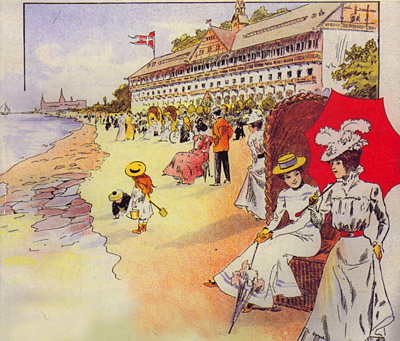| Marienlyst Hotel

| | Marienlyst Badehotel blev Nordsjællands mondæne samlingssted, som både kongelige og borgerlige gæstede og hvor man kunne forlyste sig med badning, friluftsliv og fornøjelser i det tilstødende senromantiske parkanlæg, som angiveligt rummede både Hamlets grav og Ophelias kilde. |
Marienlyst Badehotel
De bedre transportforbindelser betød at fritidslivet i Nordsjælland efterhånden fik et mere internationalt tilsnit. Et væsentligt skridt på vejen hertil er oprettelsen af Marienlyst Badehotel i 1859. Udgangspunktet er det eksisterende Marienlyst Slot som udvides med bygninger frem til og med opførelsen af den nuværende hovedbygning omkring 1897, i øvrigt samme år som kystbanen åbnes. I en periode er Marienlyst i Helsingør Kommunes eje, men sælges igen til private i 1882.
I "Badetidende" fra 1879 kan man på dansk og delvis tysk læse sig til, hvilke fremmede badegæster, der er til stede og hvilke medlemmer af byborgerskabet, der er faste abonnenter på søbadet. Desuden angives takster for benyttelse af "Kursalen og Hamlets terrasse", fartplan for dampskibs- og togforbindelser, takster for "Varme Søbade, Mineralbade, Mineralvande, Strøm-Styrte Regn-og Douchbade" m.m. Endelig ikke at forglemme termometerstanden for den forudgående uge, rigtig dansk sommer, f.eks. d.30.juni: Luften 16 grader, vandet 14, midt på dagen.

Marienlyst 1891 | 
Reklametegning | 
Marienlyst kurbadeanstalt | 
Badehotellets beliggende | 
Den første hotelbygning |

Selskabsliv på stranden | 
Nordbanen | 
Transport fra stationen | 
Marienlyst Hotel | 
Den nye hovedbygning |

Nationernes Allé |
Det mondæne mødested
Kendte personer fra indland og udland besøgte det mondæne Marienlyst, såvel det danske som svenske kongepar, og man oprettede i parken omkring Marienlyst Slot en romantisk have som angiveligt rummede Hamlets grav og Ofelias kilde. En lang række kunstnere gæstede også hotellet.
Forfatteren Herman Bang opholder sig i 1880 på Marienlyst Søbad, hvor han skriver 3.del af sin debutroman "Håbløse Slægter", efter sigende i et af de to daværende tårnværelser. Der er i romanen ingen direkte henvisninger til lokaliteten, men Marienlyst nævnes en passant i romanen Stuk fra 1886. Stuk er en nøgleroman, der skildrer storbyen København og de moderne mennesker, der lever her, undtagen om sommeren, hvor de ligger på landet. Det er for så vidt også de typer der befolkede det mondæne Marienlyst.
Herman Bang og Marienlyst
Bang gæstede Marienlyst igennem hele sit voksenliv og deltog i det sociale liv på stedet. Han deltog i basarer og optrådte med oplæsninger, som også lindrede den altid påtrængende pengenød. Daværende direktør Anders Jensen har i et interview i en lokal avis skildret Bangs tætte forhold til stedet:
"En af de første og en af de mest interesserede gæster var Herman Bang. Han kom inden vi fik lukket op om sommeren. Han var næsten med til at tælle dækketøjet, så ivrig var han, og det er ham der har æren af det smukke palmearrangement i forhallen. Han boede de første år oppe i tårnet, senere flyttede han ned i en villa i Nationernes Alle, og der holdt han små dameselskaber om aftenen. Næste dag kom han for at fortælle os, hvad hver dame havde haft på. Han var så glad når de havde pyntet sig. Om aftenen satte han sig tit på kontoret for at spise sit smørrebrød, og der drøftede han praktiske forhold med min kone, de to var så gode venner.”
Herman Bang gæstede Marienlyst så sent som 1905 og skriver engang i hotellets dagbog: "Kærest for mig er i verden Paris, Prag og Marienlyst". Herman Bang deltog også i debatten om sommerlandets udvikling, som når han i en artikel i avisen København i 1904 vender sig kraftigt imod tanken om at anlægge en jernbane igennem det naturskønne område.
Romantisk iscenesættelse
Herman Bang var en moderne mand, der dog hægede om Marienlysts romantiske aura og haveanlæg, hvor man grangivelig og indenfor gåafstand kan besøge både Ofelias kilde og Hamlets grav. Naturdyrkelsen bliver efterhånden et skemalagt og ritualiseret anliggende i bedsteborgerens livsstil. De kommercielle sider af sagen spiller nu en mere åbenlys rolle. Romantikken er her blevet til ren iscenesættelse og ydre form, hvilket også viser sig i den for tiden karakteristisk senromantisk byggestil, som præger det nye Marienlyst. vikingetiden.

Nationernes Allé | 
Cottage i Art Deco stil |
|